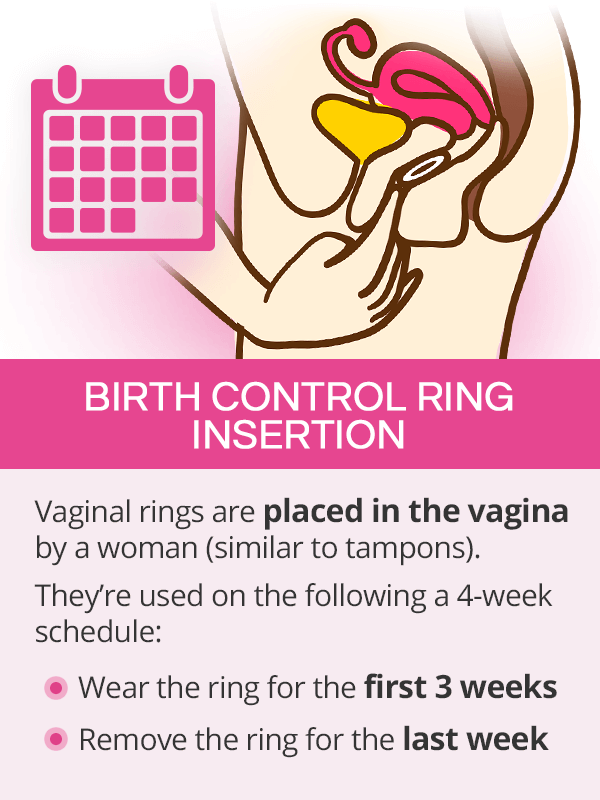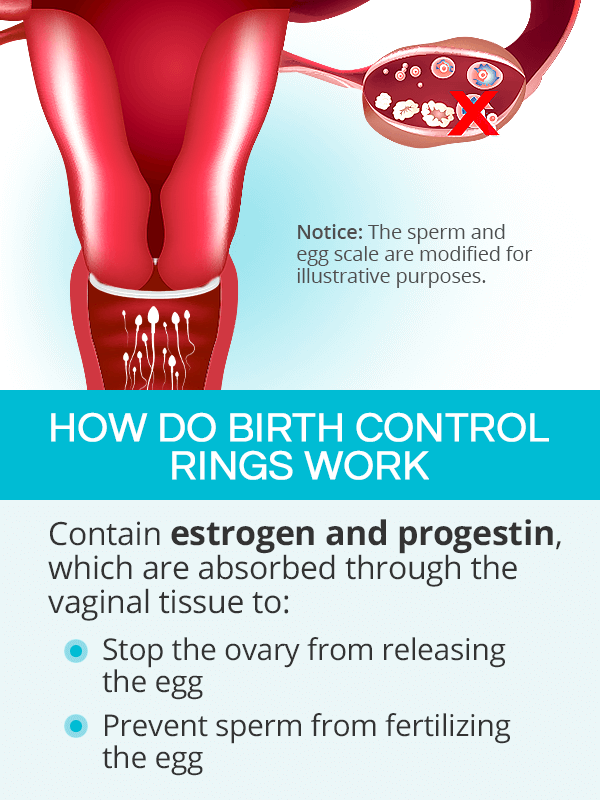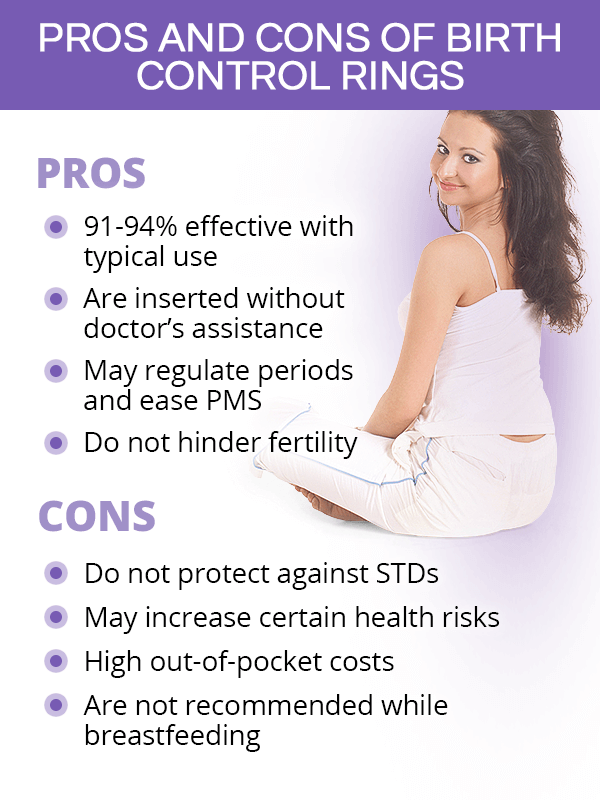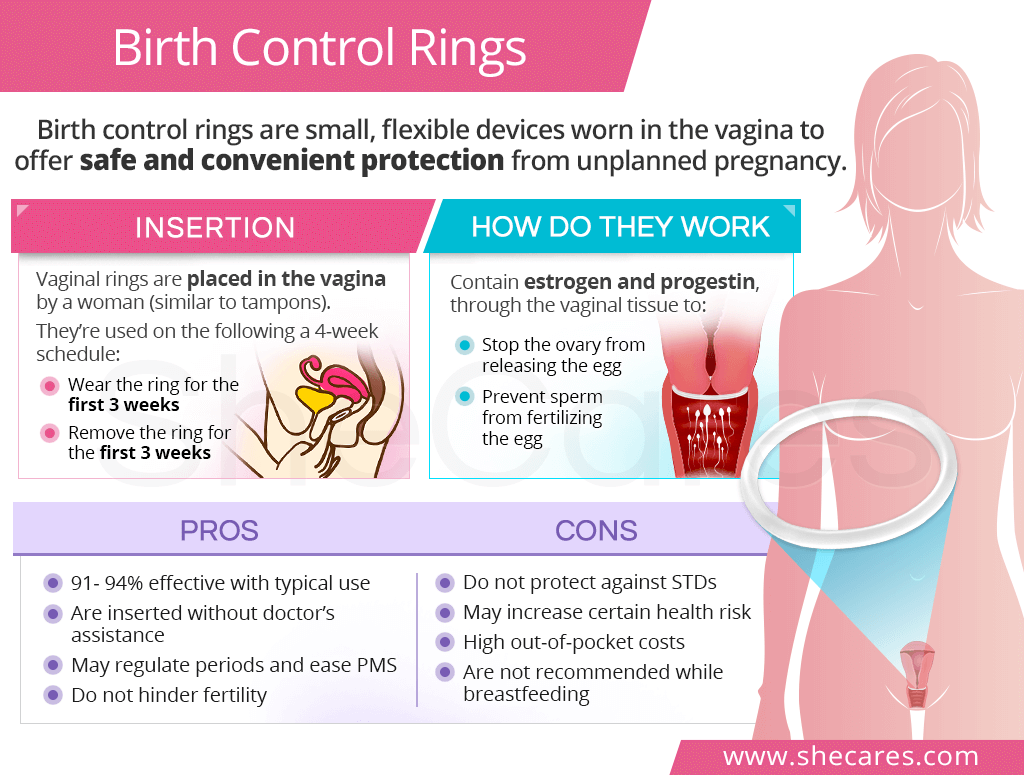What is a Birth Control Ring?
A birth control ring is a small, flexible device worn inside the vagina to prevent pregnancy. It is one of the short-acting, reversible birth control methods.
The rings are about 2 inches (5 cm) in diameter. They are latex-free and can be made of silicone or plastic, depending on the brand. Vaginal rings are obtained through doctor's prescription, but inserted by a woman.
There are two brands of birth control rings in the United States: 1-cycle NuvaRing® and the reusable, 13-cycle Annovera®.
Birth Control Ring Insertion

One of the most convenient features of birth control rings is that - unlike birth control injections or contraceptive implants - their insertion does not require doctor's assistance.
To insert the ring, a woman should gently squeeze it to elongate it and then insert it in the vagina like she would a tampon. Most women do not feel it inside their bodies, including during sex.
Insertion Schedule
Regardless of their type, vaginal rings are used on the following 4-week schedule: wearing the ring for the first three weeks and taking it out the fourth week, allowing a period to happen.
However, there is a key difference between the two types regarding their re-insertion:
NuvaRing®: Once the ring is removed after three weeks, it should be thrown away, and a new ring should be inserted to start the new 4-week cycle.
Annovera®: Once the ring is removed after three weeks, it should be washed and stored during the fourth week. To start the new 4-week cycle, the same ring is inserted back in the vagina. It can be re-used for one year.
Accidental Slips
In most cases, the ring is unlikely to fall out of the vagina. However, if it does fall out or a woman decides to take it out during sex, she has a three-hour window to wash it under cool water and insert it back. If three hours have passed, it is recommended to use another contraceptive method for seven days since its re-insertion.1
How do Birth Control Rings Work?

A birth control ring contains two reproductive hormones, estrogen and progestin (a synthetic form of progesterone). When released, hormones are absorbed through the vaginal tissue and into the bloodstream.
This, in turn, alters the levels of the body's own hormones, resulting in the following changes:
- Thickens cervical mucus to prevent the sperm from fertilizing the egg
- Stops the egg from being released from the ovary (ovulation)
- Thins the lining of the uterus to prevent implantation
Most women start using birth control rings within the first five days of their periods, preferably their onset. It takes about seven days for the rings to start working. As such, a back-up contraceptive method is recommended for the first week.2
Pros and Cons of Birth Control Rings
Oftentimes promoted as a more convenient alternative to the pill, vaginal rings definitely offer numerous advantages. Yet, as with all medications, their use involves certain disadvantages that need to be taken into consideration.
Pros of Birth Control Rings

- With perfect use, the rings are 99% effective. With typical use, estimated effectiveness ranges from 91-94%.3,4
- Insertion of vaginal rings is done once a month, without doctor's assistance.
- The rings may regulate periods and relieve premenstrual syndrome (PMS) symptoms, like cramps or acne.
- Upon removal of the ring, menstrual cycle and fertility are restored within a month or two, without prolonged delays.
Cons of Birth Control Rings
- Vaginal rings do not protect women from sexually transmitted diseases (STDs).
- The rings' effectiveness heavily depends on a woman remembering to change them as prescribed.
- Their out-of-pocket cost may be as high as $200, on top of a doctor's fee.5
- Birth control rings may increase the risk of blood clots, stroke, and heart attack.6,7
- Since they contain estrogen, vaginal rings are not a good option for women with hormone-sensitive cancers.6,7
Key Takeaways
There are numerous features to birth control rings that may attract women needing a reliable form of contraception. Unlike birth control pills, which are taken daily, the rings are only inserted once a month. Unlike contraceptive implants or injections, their insertion does not require a doctor. They also do not affect fertility, which is a plus for those thinking about pregnancy in the nearby future. However, as a combined-hormone method of birth control, vaginal rings may not be the best option for women who cannot or do not want to take estrogen. They also do not protect against STDs and may involve high out-of-pocket costs. Despite these disadvantages, thousands of women find them the perfect fit for their needs.
Sources
- Better Health Channel. (2019). Contraception - vaginal ring. Retrieved September 7, 2020 from https://www.betterhealth.vic.gov.au/health/healthyliving/contraception-vaginal-ring
- CDC. (2020). Contraception. Retrieved September 7, 2020 from https://www.cdc.gov/reproductivehealth/contraception/index.htm
- FDA. (2018). FDA approves new vaginal ring for one year of birth control. Retrieved September 7, 2020 from https://www.fda.gov/news-events/press-announcements/fda-approves-new-vaginal-ring-one-year-birth-control
- International Journal of Women's Health. (2010). Examining the efficacy, safety, and patient acceptability of the combined contraceptive vaginal ring (NuvaRing®). Retrieved September 7, 2020 from https://www.ncbi.nlm.nih.gov/pmc/articles/PMC2990910/
- Mayo Clinic. (2020). Vaginal ring. Retrieved September 7, 2020 from https://www.mayoclinic.org/tests-procedures/nuvaring/about/pac-20394784
- Medline Plus. (2020). Birth control and family planning. Retrieved September 7, 2020 from https://medlineplus.gov/ency/article/001946.htm
- Office on Women's Health. (2017). Birth control methods. Retrieved September 7, 2020 from https://www.womenshealth.gov/a-z-topics/birth-control-methods
- Teens Health. (2018). Birth Control Ring. Retrieved September 7, 2020 from https://kidshealth.org/en/teens/contraception-ring.html
Footnotes:
- Beth Israel Lahey Health Winchester Hospital. (n.d.). The Vaginal Ring: An Alternative to Birth Control Pills. Retrieved September 7, 2020 from https://www.winchesterhospital.org/health-library/article?id=26024
- Planned Parenthood. (2010). How long does it take for NuvaRing to become effective? Retrieved September 7, 2020 from https://www.plannedparenthood.org/learn/teens/ask-experts/how-long-does-it-take-for-nuva-ring-to-start-working-when-you-first-start-using-it-i-went-off-the-pill-a-few-months-ago-and-have-been-just-using-condoms-since
- Contraception. (2013). Contraceptive failure in the United States. Retrieved September 7, 2020 from https://www.ncbi.nlm.nih.gov/pmc/articles/PMC3638209/
- FDA. (2020). Birth control. Retrieved September 7, 2020 from https://www.fda.gov/consumers/free-publications-women/birth-control
- Planned Parenthood. (n.d.). Birth Control Ring. Retrieved September 7, 2020 from https://www.plannedparenthood.org/learn/birth-control/birth-control-vaginal-ring-nuvaring
- NuvaRing®. (n.d.). Consider NuvaRing: Important Safety Information. Retrieved September 7, 2020 from https://www.nuvaring.com/
- Annovera®. (n.d.). Annovera: Important Risk Information. Retrieved September 7, 2020 from https://www.annovera.com/
